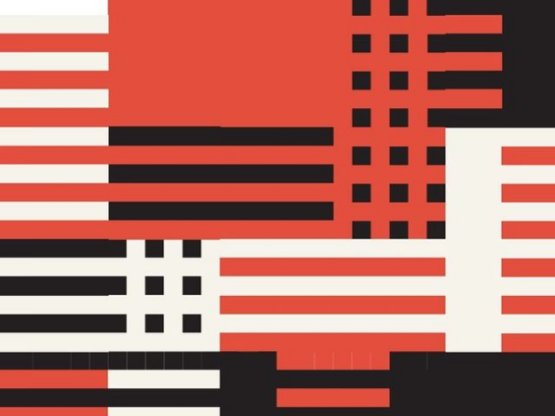Development | Peer reflection, thinking by doing, testing and refining design
REFLECTIONS ON LECTURES AND SOURCE MATERIAL
—
LECTURE
Q1: What is your development and reflection process?
I think Offshores approach in research, iteration and reflection makes for the basis of good practice which is also echoed by Vince Frost. I also think the stepping back, reviewing and further research of the process at every stage is important for the final outcome to work in its ideas, meaning and execution. Werkflow make an interesting point in relation to question 2 where they ensure that the client work they do helps to pay for and create space for the self initiated projects to happen. I think if you don't have the financial security in place for a self initiated project in happen, then more often than not the project will have to be created outside of working hours which can result in a poorly executed, ill thought through outcome due to time constraints. This can also have a negative effect on your day to day work through tiredness and the inability to give yourself the space to step back from the work. It is also important to consider the financial aspect if you intend to get the thing made.
Offshore's reflection process allows for discarding the bad and refining the details in all aspects of the creation, with an emphasis on going back to the core of the message they most want to highlight, the perspective that is meaningful and relevant to them and the story they want to tell. This stripped back approach to presenting an idea in as simple way as possible speaks to me in terms of my own project. As Hey studio point out, simplicity in design is the hardest thing to achieve and takes multiple iterations through trial and error to remove the unnecessary.
Werkflow adopt a slightly different approach whereby their work is almost put to a social media forum for response from their peers. I think this is an effective way of getting input in order to refine the work and to see what is and isn't working.
In my own client based practice I am used to receiving a brief and carrying out a small amount of research before jumping straight into design leaving little or no time to review or refine the work in the process. This is usually due to budgetary and time constraints. My goal would be to build in some of the learnings here into my working practice so I have time to research, explore, play and experiment.
Q2: How has production, risk, failure and your own personal ambition affected the outcome?
It's interesting that Offshore relinquish control until they are sure that the research and iteration process has defined the direction of the outcome. They employ risk and failure into their process and are not hindered by the fact that they may need to start the process from scratch if the direction isn't working. As Christoph points out you have to "stay invested in the work". They also use the time to up-skill and explore new ways of doing things which will inform the final outcome. I also like the assertion by Vince Frost that for self initiated projects 'he is the client'. I think it's important to remind yourself that you are doing this on a very personal level and that the work should reflect your thinking and vision as a designer.
Hey studio have tapped into their own success through their self initiated projects in creating separate revenue streams for the work to exist and be sold. In their shop, they can create a consumer facing experience and in using print on demand methods they are also able to keep any associated costs to a minimum.
One thing that strikes me about all of the lecturers is that the final outcome must have a purposeful final format and be able to be presented or taken home by the intended audience. This is not self initiated, self indulgent work created in a vacuum. It is purposeful work to create discussion, experience, financial reward and public awareness.
TAKE OUTS
— Use the research process to reveal your particular area of interest.
— Use cultural media to inform your research, not just graphic design.
— Remind yourself that you are the client. This is a personal take on the world around you and should reflect you as a designer.
— What is significant? What is your intended message, story or narrative?
— Challenge your ideas, and iterations.
— Take risks and explore multiple iterations.
— Decide what to keep or throw away, or whether you need to start again.
— Simplify: Make it easy for your audience to comprehend.
— Collaborate with and gain insight from your peers.
— Don't worry about the final outcome and trust the process.
— You can't force an idea - take a step back.
— Look at the details once all the information and interactions have been gathered.
— Find avenues for peer to peer and audience reflection.
— Try to build a financial safety net to allow you time and production for your self initiated project.
— Review the whole process at the end: what worked, what didn't.
—
RESOURCES
KESSELSKRAMER - ERIK KRAMER/TAKE OUTS
— Embrace failure, confusion and mistakes.
— Work against perfection to create disruptive work.
— If it is not liked, it doesn't mean it is not good.
— Look for the unexpected.
— Find inspiration in mistakes.
Erik Kessels' presentation reminded me of my own love of mistakes in my own photography where light leaks, double exposures or broken cameras have all played a part in creating something unique — images that you would not have come to if the tools had worked properly in the first place. Some of which I have included below.
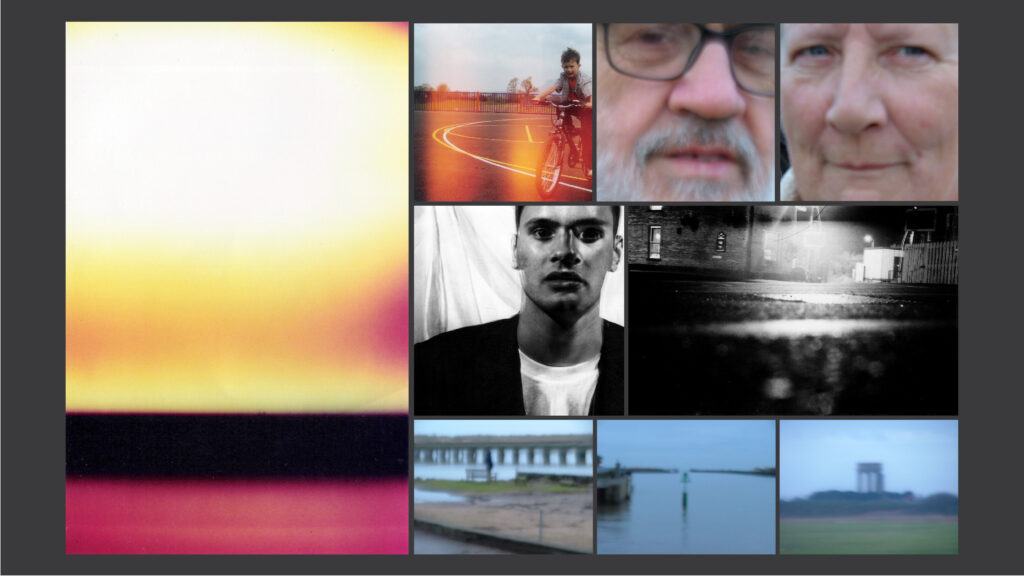
—
Workshop Challenge
Imagine and make one design response to your self-initiated project brief.
Your direction should be informed by peer feedback to your mood boards and initial rough visuals.
THE IDEAS WALL
The best responses were towards mood board 1 so I will explore this in my sketching process. I am still torn between 1 and 3 as I am drawn to the illustration on mood board 3. It combines dark subject matter with humour which I think fits with my brief where complex issues raised during lockdown require a draw for my target audience.
At the time of revisiting the ideas wall (07/10/21) there wasn't any feedback on my sketch work. I am going to press on with a combination of the iconic, typographic and illustrative styles of sketches one and two (top left and top right).


THE IDEAS WALL
Mark responded well to the revised mood board and seems to get my direction of using colour, type and icons to create a visual language so hopefully I am on the right track.
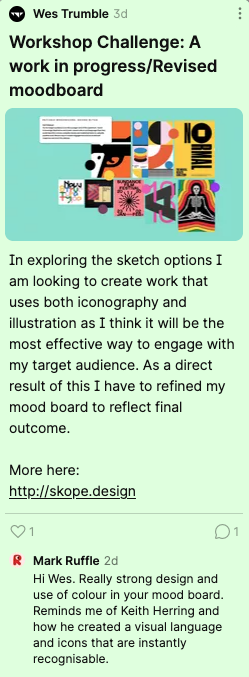
—
Make prototypes and experiment with design and production techniques to ensure you engage with your target audience. Remember to record all tests, even if they fail, and add them to the Ideas Wall and your blog.
Upload your design developments to the Ideas Wall and add further reflection on your blog. We want to you to demonstrate how your project has developed.
FURTHER SKETCHES: BESPOKE TYPEFACE
I am looking to design a bespoke a bespoke typeface that aligns with the style of the icons. I liked the initial sketch for the word 'Normal' from my first sketch and am going to develop this further.
TYPE SKETCHES
Further exploration for the typography. I like the idea of the typeface being disrupted in some way to make the font harder to read forcing the viewer to work harder to engage with what are complex and serious issues.
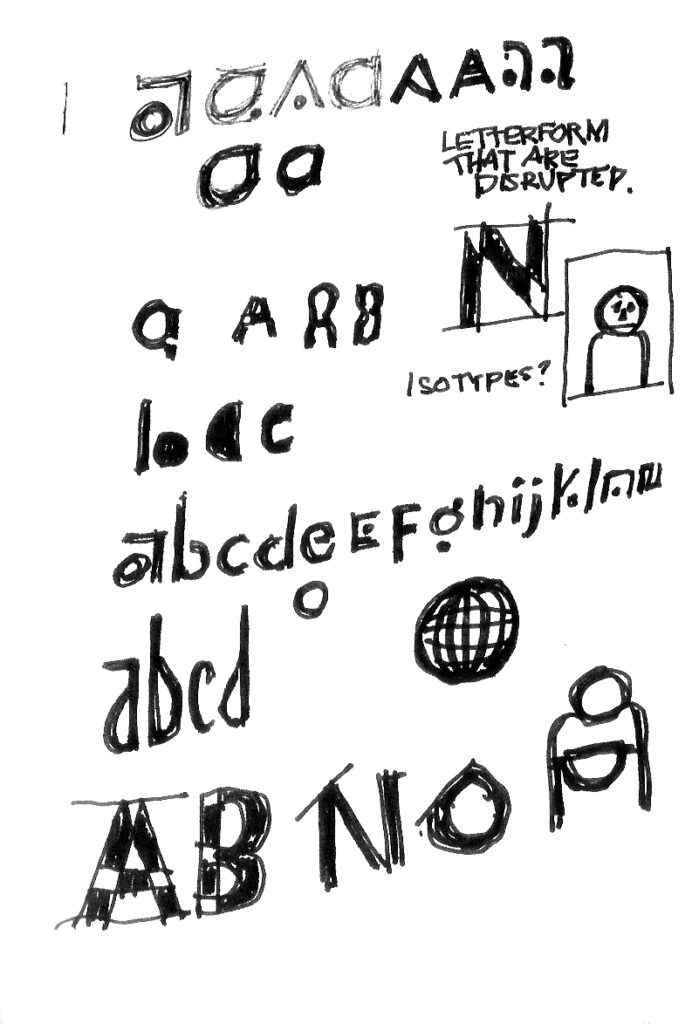
TYPEFACE DEVELOPMENT
Refining and drawing the final font. I decided due to time constraints to adapt a typeface rather than creating the design from scratch. I think by choosing to create a display style caps only font, the messages can still be easily read and that there is enough similarity between the letter style for the font to work as a whole. The advantage of using a pre-existing font is that I can use a combination of the non-deconstructed style with my adapted font, which gives me two styles to play with.
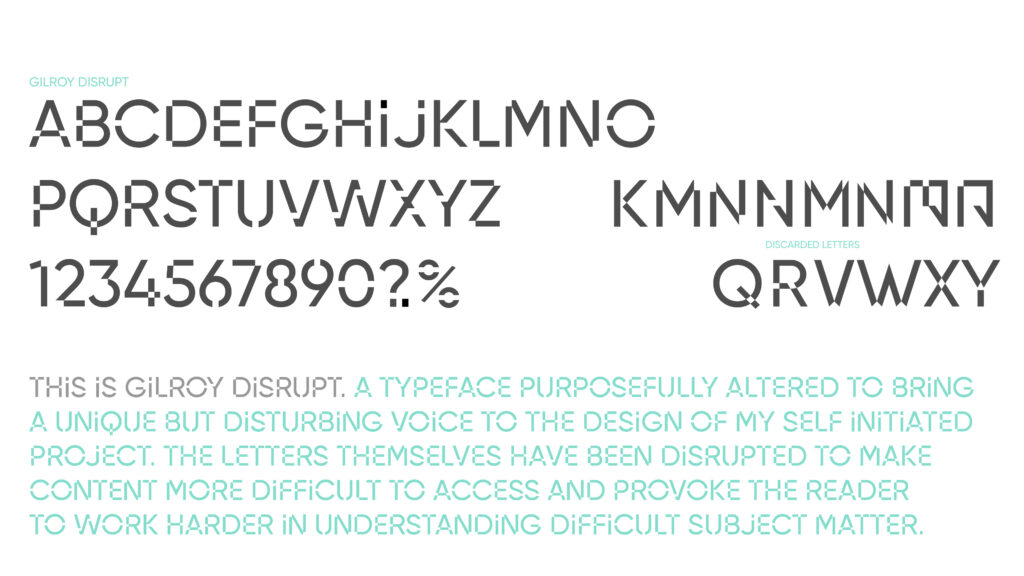
As part of the process I found that certain letters wouldn't easily lend themselves to the overall style. I have treated these individual letters (C, O, S, U, V, W, X) as stencilled versions and think they actually fit with the overall look and feel of the font when it is typewritten. This style is actually based on a font I started drawing way back in the nineties so it is nice to see it come together and be used for something. A revived self initiated project within my self initiated project.
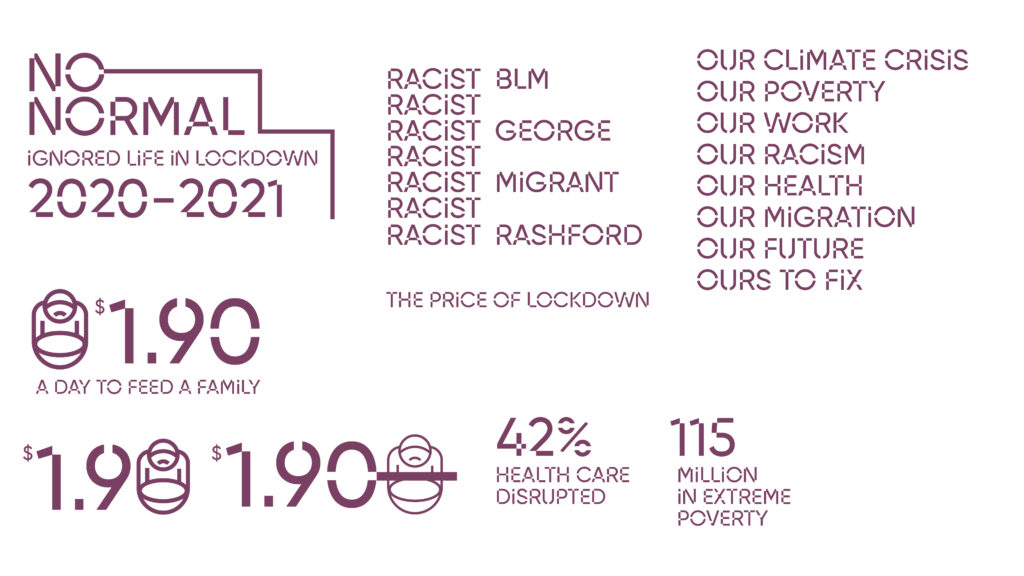
ABOVE: Starting to explore the language and style of the project as well as introducing the icons. I think the icons themselves are not working with the overall style so this needs further exploration. I like the idea of adding 'Our' to key headings because it gives ownership to the issue without blaming any one cause.
ROUGH PROTOTYPE
A rough scamp to work out content, layout and number of icons/illustrations required for the project. This has made me realise that the scope of the project is still too broad so I am narrowing it down to four themes that all play a part in the same story: Climate, Poverty, Migration and Racism.
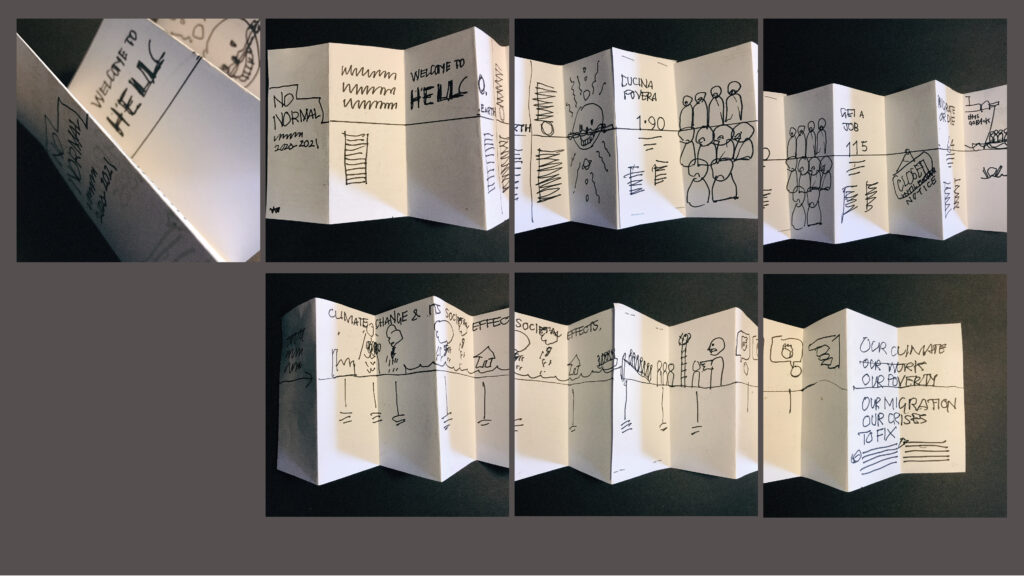
DESIGN DEVELOPMENT/REFINEMENT
I have started to bring all the elements together to create a speculate idea for an exhibition refining the narrative, delineating the facts, bringing colour and systems for the typography and creating the icon sets. I have also looked at dividing each section with illustrative depictions which can be used effectively across social media story platforms. The idea would be to create a sticker set that can be used to add to the debate and grow discussion with the main goal to get people involved in issues on a grass roots level and through funding projects. I think as an exhibition, this could sit in the clinics where you wait to get your booster jab.
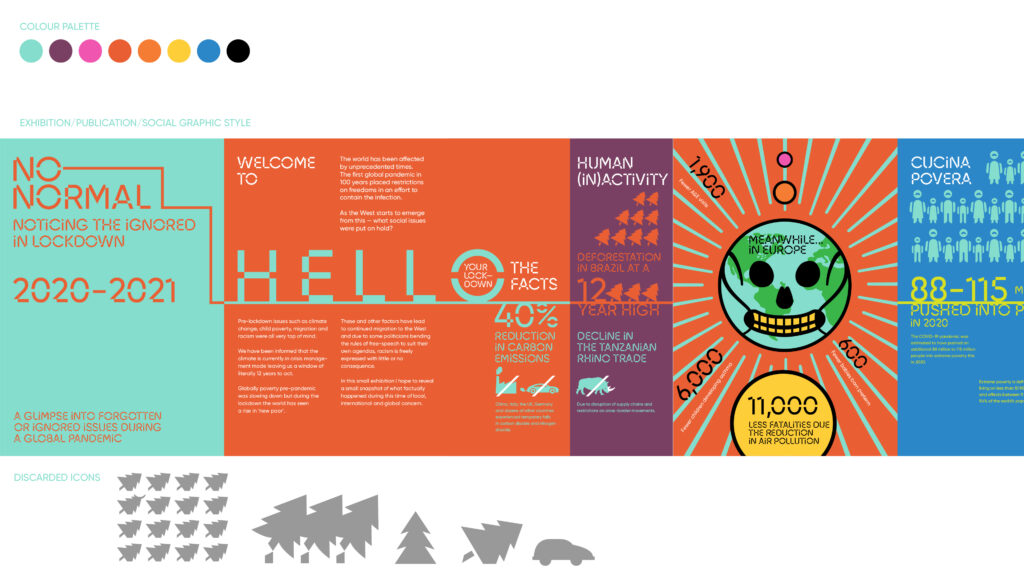
THE IDEAS WALL
Ingrid came back with an affirmation that for her this is going in the right direction so I will press on...

Final Outcome
Design and deliver your final outcome, in line with your original aim and objectives. Post the final outcome on the Ideas Wall and reflect on your blog.
The not quite final, final outcome.
If I review my initial briefing question: What social issues were ignored during lockdown?, I think I have answered my question and brief in part although this is a greatly paired down version of where I was going to go initially. I think the question was too broad and that it makes more sense now that I've paired it down to four subject areas: Climate, Poverty, Migration and Racism. This has enabled me to focus on both the affects of lockdown on my selected social issues while also looking at the interconnected stories of how one cause comes to affect another.
I think I have also managed to stay more or less in the area of my 16-28 year old audience both graphically and content wise although this needs to be explored to work online as well as offline. Hopefully this is something I can address in the timeframe next week. I would also like to create some visual mock-ups of what the entire piece will look like: Exhibition Panels, Booklet, Social Posts and Stickers.
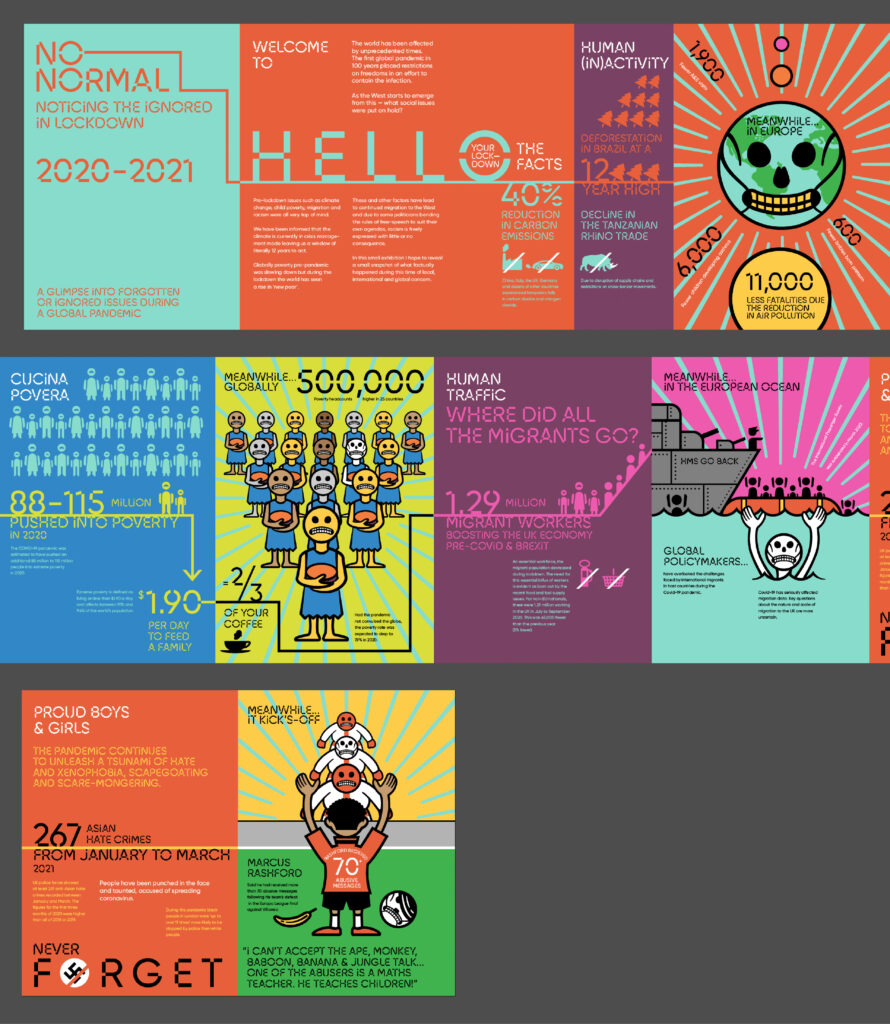
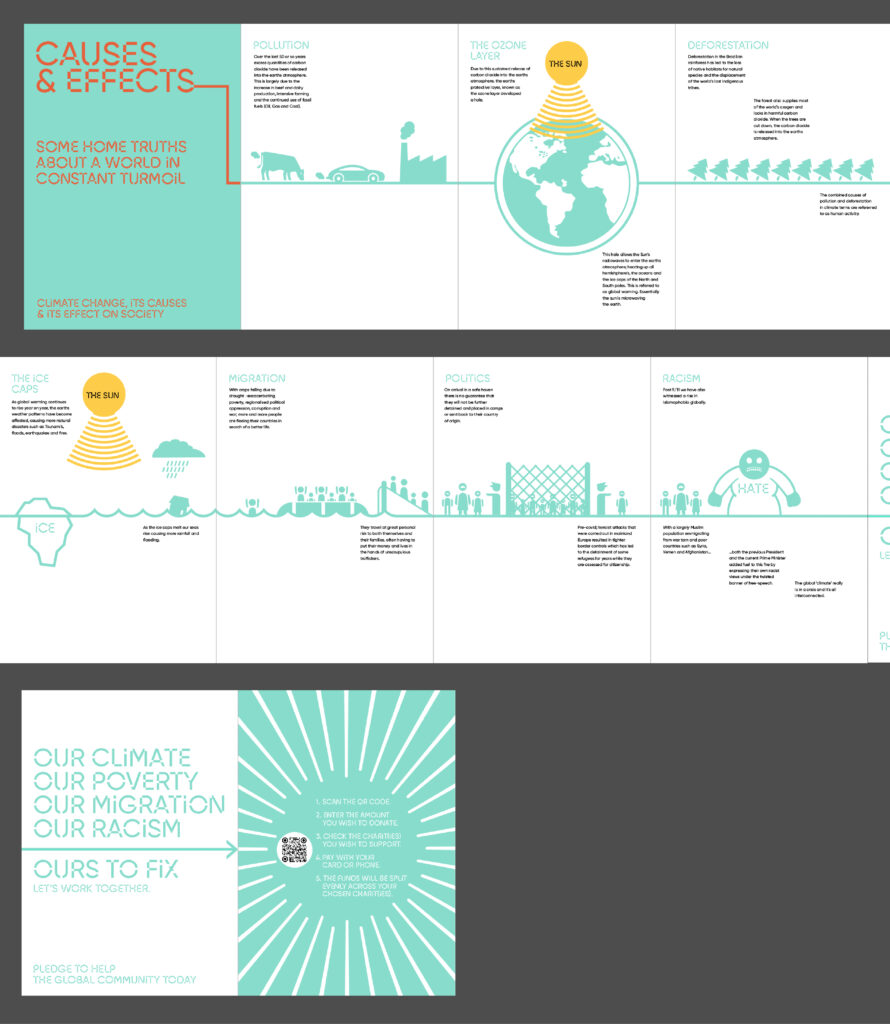
On the reverse side (above) I have explored the idea of generating funding by add money to a treasury that divides the funds across your chosen charities and splits them evenly. Not entirely sure how this can be implemented by I would like to see the funds bypass governments and get the the causes directly.

